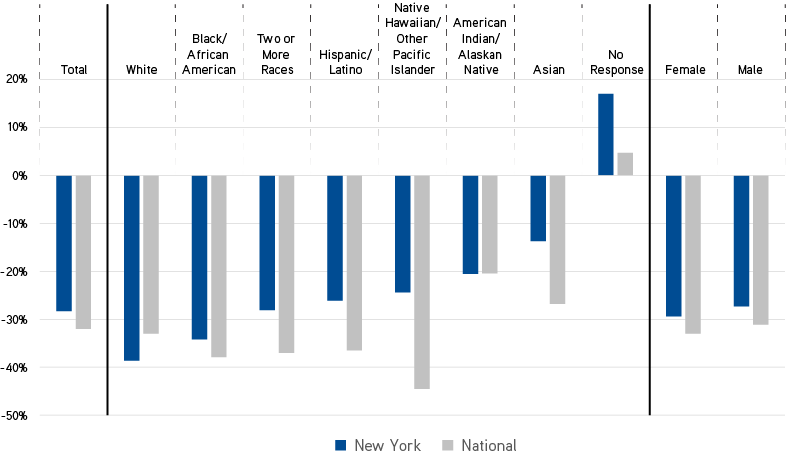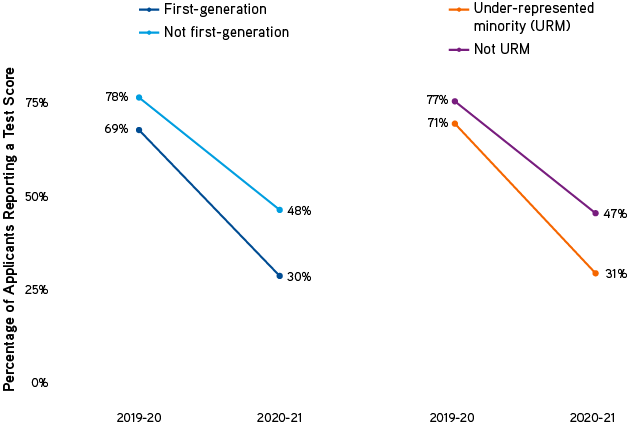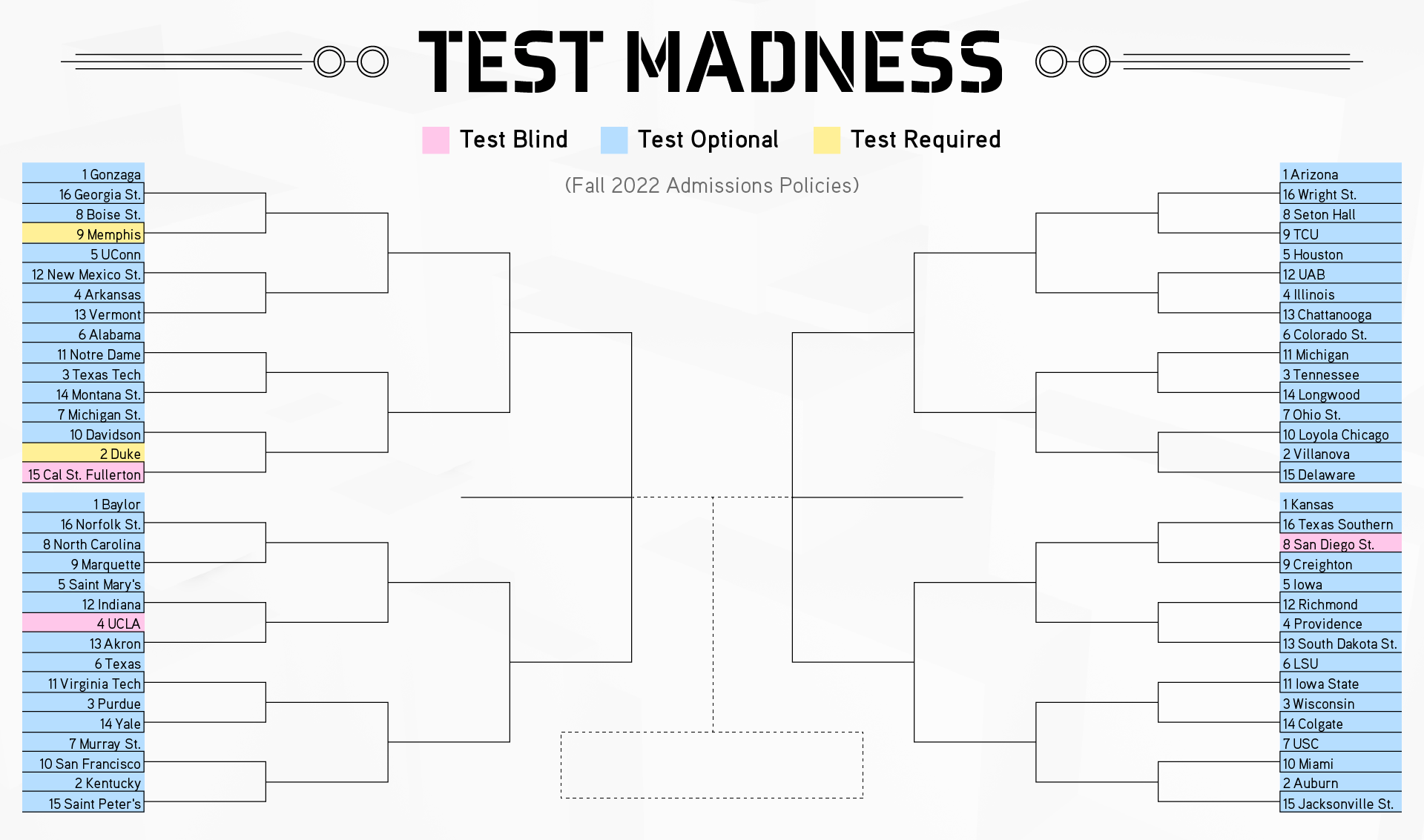The madness of March at colleges isn’t restricted to the basketball court.
High school students are facing a far different college application process this year than did their peers just a few years ago. In 2019, most college-bound juniors would have been running through SAT and ACT test prep quizzes while watching the Virginia Cavaliers defeat the Texas Tech Red Raiders in the final game of the NCAA men’s basketball tournament. Today, many high school juniors will be preparing college applications that give them the option of not including any standardized tests scores, regardless of their decision on whether to take these tests.
Studies have found that colleges’ participation in high profile sports tournaments increases the quantity and quality of applications,[1] and that “Cinderella” runs in the NCAA’s Men’s Basketball Tournament where teams’ performance exceed the expectations of the viewing public result in higher revenues for those schools. As prospective fall 2023 freshman watch this year’s tournament and ponder their academic futures, the landscape of college admissions is changing. Even as COVID-19 campus restrictions are relaxed and universities return to normal, many admissions offices have adjusted the information required to be submitted with college applications, specifically, the requirement to take standardized tests and report those scores. Some of these changes are permanent, and all are changing the face of the college application process and influencing the futures of their schools.
Test Optional Definitions
Test-Required: All applicants were required to submit scores and the scores were considered in application decisions. A limited number of exemptions could be granted to take into account individual circumstances.
Limited Test-Required: General admissions are test optional, but applicants are still required to submit test scores to be considered for specific programs or merit based scholarships.
Test-Optional: Tests scores are reviewed and considered for admissions only when submitted.
Test-Blind: Test scores are not considered in the application decision even if submitted.
In this blog post, we provide an overview of the test optional movement, the impact of COVID on the application process and college admissions decisions, and the role standardized tests may play in the future of the college admissions process.
The Test-Optional Movement: Pre-Pandemic
The test-optional movement began to gain speed prior to the onset of the COVID-19 pandemic, largely as a move to address concerns of persistent socioeconomic biases in standardized college admissions test results, as research found a correlation of scores to race, socioeconomic status, and gender. More than 10 percent of all “selective” institutions—i.e., smaller liberal arts colleges—adopted test-optional policies between 1987 and 2015. Most of the limited research done on this restricted pool of institutions, however, found little increase in diversity on campuses from these institution’s enactment of test-optional admissions policies (see, for example, Belasco et al. (2015), Sweitzer et al. (2018), and Rosinger and Ford (2019)). A more comprehensive look, albeit still among a limited pool of institutions adopting test-optional admissions primarily as a way to achieve greater diversity of their student bodies, showed that the shift in policy resulted in a slight increase in student diversity. An April 2021 study on enrollment patterns from school years 2005 to 2015 in nearly 100 private colleges found that adopting test-optional policies was associated with a 10 to 12 percent increase in first-time students from underrepresented racial backgrounds, a 3 to 4 percent increase in Pell Grant recipients, and a 6 to 8 percent increase in women. Even so, one review of this study noted that the baseline number of students in these subgroups on many campuses was so low that even the percentage increases noticed “didn’t change the demographics of the campus all that much,” with the total share of students of color shifting by only one percentage point.
While the shift to test-optional admissions policies largely originated with selective, private liberal arts colleges and universities, the movement spread to include numerous regional private colleges, public colleges and universities, and state systems even before the outbreak of the COVID-19 pandemic in the spring of 2020. For example, the University of New Hampshire decided in May 2019 to become test-optional, and before that, the University of California (UC) system President Janet Napolitano asked its Academic Senate to evaluate standardized testing practices in July 2018. By fall 2021, the UC system switched to fully test-blind for all applicants, using any ACT/SAT scores submitted only for course-placement decisions and only after admissions offers are made.
The Impact of the COVID-19 Pandemic on Standardized Testing
The onset of the COVID-19 pandemic in the spring of 2020 brought the closure of, among many other things, government offices, private businesses, churches, recreation and entertainment venues, and yes, local SAT and ACT test-taking sites. College entrance exam dates across the country were cancelled, and local test center sites announced additional closures well into the summer and fall months. For the high school class of 2021, more than one million SAT test registrations were canceled, and by the fall, approximately 700,000 fewer students had taken the exam than their peers in the class before them, a drop of about 32 percent. The number of students taking the ACT dropped by 22 percent, or more than 375,000 students in 2021 compared to 2020.
Test-taking disruptions caused by COVID-19 were felt acutely in New York State where the number of SAT-takers fell by nearly 28 percent. Only 55 percent of the class of 2021 took the SAT exam compared to nearly 80 percent in the previous two years.
| New York State SAT Participation | |||
| Graduating Class Year | 2019 | 2020 | 2021 |
| Size of HS Class | 205,027 | 203,793 | 210,310 |
| Number of Test Takers | 162,179 | 160,484 | 116,219 |
| Participation Rate | 79.1% | 78.7% | 55.3% |
| Number (%) of test-takers submitting scores | 113,257 (69.8%) |
111,895 (69.7%) |
50,493 (43.4%) |
SOURCE: New York SAT Suite Results Assessments Annual Report.
The disruption in test-taking was universal but not equal among racial and ethnic student groups (see Figure 1). SAT participation for white students in New York dropped by nearly 39 percent, for Black students by 34 percent, Hispanic students by 26 percent, and Asian students by nearly 14 percent.
Change in SAT Participation

SOURCE: New York SAT Suite Results Assessments Annual Report.
In response to COVID-19 disruptions in test-taking, virtually all public and private colleges and universities implemented a test-optional policy admissions policy for fall 2021. The only state that did not was Florida, and, according to system administrators there, applications to the 12 state universities dropped by as much as 50 percent in fall 2020 because of students either not having the required scores to submit or choosing to apply at institutions that didn’t require scores to be reported.
According to administrators of the Common Application, test-score reporting fell by 30 percentage points nationwide between 2019 and 2021. In the first year of pandemic-related test-optional admissions, 57 percent of students did not submit scores for any application, 24 percent submitted scores only to select institutions and not to others, and only 19 percent of college applicants submitted scores with all applications. The percentage of first-generation students and under-represented minority students not reporting scores grew by more than the average for all other students nationally.
Change in Percentage of Applicants Reporting a Test Score

SOURCE: Common App.
Nearly 90 percent of the Common Application’s 900+ members did not require the SAT or ACT for fall 2021 applicants.
The Impact of Test-Optional Admission Policies
The impact of test-optional admissions policies has been difficult to discern, although the body of research is growing. Among the concerns is that test-optional is a relatively recent policy change in higher education admissions, with only three years of widespread adoption of these policies. As a result, data required to assess the long-term impacts of these changes do not yet exist. Ideally, we want to understand the impact of test-optional admissions on student retention, performance, graduation, and post-graduation success to better inform the development of a permanent policy. We also want to understand what the short-term effects (e.g., increased enrollment of underrepresented ethnic/racial minorities, lower-income students, etc.) and the long-term effects (economic success in the employment market, for example) of these policies are. The ability to assess the impacts in a statistically significant analysis is not available until several years after implementation. Further, much of the research done on early-adopters of test-optional have focused on the experiences of smaller liberal arts colleges, many of which are considered “selective.” Public institutions, which typically serve a broader socioeconomic base of students, have not been highly represented in much of the longer-term research that has been done to date. Additional analysis needs to be completed to better understand the effects in public universities.
Importantly, we are still months away from seeing how the first overwhelmingly test-optional class fared in their first year of college. Students admitted in fall 2021 still have a few weeks of their freshman year remaining. Even when data is available for this cohort, our understanding of the impacts of test-optional policies will be imperfect. Many of these students submitted test-optional applications out of necessity and not by choice due to limited access to testing opportunities. The first cohort of students with regained wide access to ACT and SAT testing and a largely unrestricted option to submit scores will arrive on campus in fall 2022. Analysis of the application and enrollment decisions made by this group—and their persistence and completion rates in college—will provide more useful insights into the impact of test-optional policies.
Assessing the impact of test-optional college admissions on longer-term performance is further complicated by other disruptions created by responses to the COVID-19 outbreak. Students most affected by colleges’ shift to test-optional admissions policies also were forced to complete as much as a year and a half of their high school education virtually. The impact of the disruption to high school education is likely to ripple into these students’ first several months of college, impacting first-year retention and persistence rates, course-placement decisions by colleges, and more. It is likely to be years before we can fully understand the longer-term consequences of the high school disruptions and learning loss attributable to changes made during the COVID-19 outbreak. Separating the impact of COVID-related disruptions from test-taking and test-score submission decisions will also be challenging, particularly in the short-term.
The Future of Test-Optional Admissions
While test-taking access looks likely to return to normal this year, and the College Board has further increased access to the SAT by introducing online test-taking options, by the end of 2021, nearly 80 percent of bachelor’s degree-granting colleges and universities had already made the decision not to require ACT or SAT scores from students seeking to enroll in fall 2022. Many institutions have also elected to go long-term or even permanently test-optional. To date, 20 public institutions or systems have gone permanently test-optional, the largest being the University of California system (#4 UCLA, #8 SDSU, and #15 Cal State Fullerton). Additionally, in nine other public university systems, states have allowed each campus the ability to set its own policies, with most staying test-optional.
The movement to test-optional admission policies is not just in the hands of college and university administrators. On May 25, 2021, Colorado (#8) Governor Jared Polis signed legislation that gave all public four-year colleges and universities in the state the option to require or not require national test scores in their admission process. And in Illinois (#4), Governor J. B. Pritzker signed legislation on July 9, 2021, that requires all public colleges and universities in the state to have test-optional admissions.
Most schools and university systems have elected to maintain test-optional only temporarily, taking a wait-and-see approach as the full impact of test-optional admission policies has yet to be seen, measured, and properly analyzed. The University of Tennessee (#3), for example, has adopted a five-year test optional policy with the stated intent that this period will allow the institutions to better assess the impact of test score submission decisions.
Indeed, there are number of unanswered and important questions about test-optional policies. Among them:
- How have admissions offices changed their admission decision-making?
- Has the switch to using other measures upon which offers of admissions are based—including high school GPA, reputation of high school of origin, access to Advanced Placement (AP) courses, and more—raised new problems, challenges, or biases?
- What types of students choose to submit applications without test scores, and are there enrollment patterns emerging, whether increases or decreases, for any of these groups?
- Are there differences in first-year success rates for students admitted without entrance exam scores? Are there longer-term persistence and success issues?
More research needs to be done—and more time needs to pass to allow effects to be properly measured—to properly gauge the impact of test-optional college admission policies. Until then, the madness of this year’s springtime test-taking and decision-making season continues.
Correction: An earlier version of this bracket incorrectly labeled “16 Georgia St.” as “Test Required.” The bracket has been updated to reflect Georgia State’s “Test Optional” status for fall 2022 admissions.
ABOUT THE AUTHOR(S)
Brian Backstrom is director of education policy studies the Rockefeller Institute of Government
Laura Schultz is executive director of research at the Rockefeller Institute of Government
[1] Devin G. Pope & Jaren C. Pope, “The Impact of College Sport Success on the Quantity and Quality of Student Applications,” Southern Economic Journal 2009, 75(3), 750-80, http://citeseerx.ist.psu.edu/viewdoc/download?doi=10.1.1.702.5645&rep=rep1&type=pdf.


